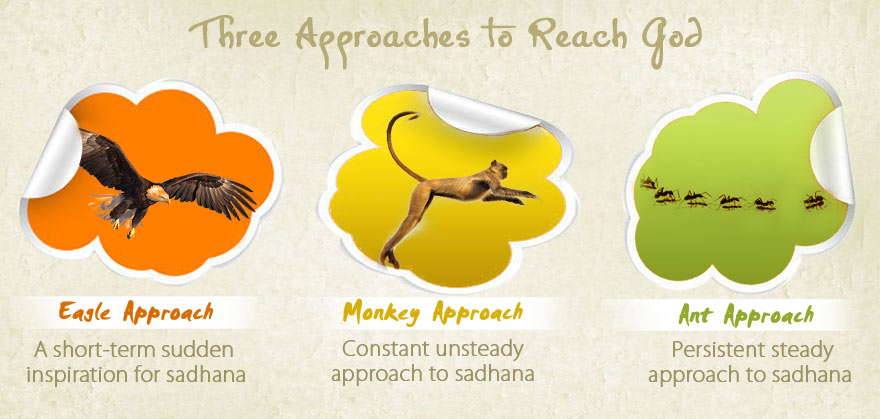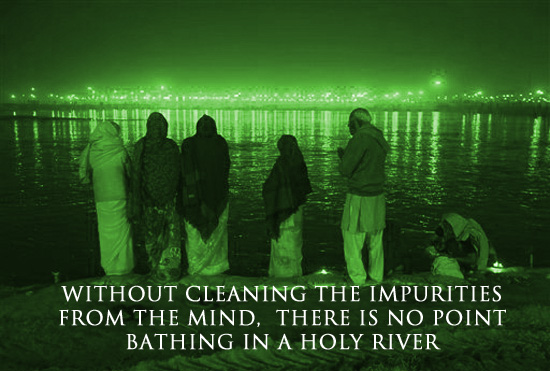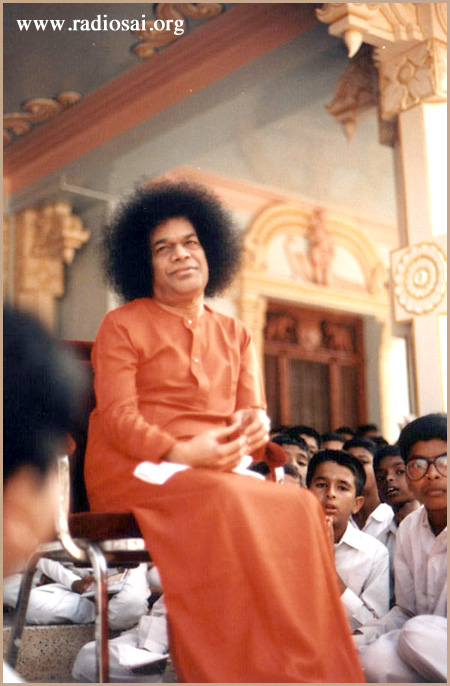|
|
| 'Like' us on Facebook | Follow us: |
Posted on : Jan 03, 2013
RADIO SAI STUDY CIRCLE – 8
SOS: Swami On Sadhana
Part 05
CRITICAL SUCCESS FACTORS FOR FRUITFUL SADHANA
KMG: Patience and perseverance are very important. Bhagawan says that there are three approaches through which an aspirant strives to reach God. The first one is the Eagle Approach. The eagle scoops down at a very high velocity towards its chosen target and grabs it quickly. Due to the speed, it may damage or even lose the target. This is what many devotees do – an overnight stunt of some Maha Yagna or sudden intense tapas.
GSS: We all are used to that.
KMG: Or the notion that some sporadic act of favour will please the Divine. This is not the path that Bhagawan prescribes. The second one is that of a monkey. The monkey has this whimsical trait of jumping from one object to other. It is not steady. It is never satisfied with one. Similarly a devotee may worship one form of God today and another one tomorrow and on the third day he stops the Sadhana. A week later he starts again. He basically lacks conviction and sturdiness just like a monkey.
GSS: You remind me of my efforts!
KMG: Most of us are reminded of ourselves. But the third and the final approach - of the ant that takes tiny, yet firm, steps of conviction towards its chosen goal. This is what Bhagawan prescribes. Only sturdy and consistent Sadhana can win the grace of the Lord.
 |
GSS: Wonderful!
SG: In fact Ganesh, considering the monkey example, Swami used to say it is very important that in order to find water you do not dig wells everywhere. Some people start digging at one place thinking that is the best place to find water. After about 10-15 feet they move to some other place and start digging for water again. Swami says this will only create hundreds of pits, but not wells.
Likewise, Swami extends His analogy of this well to both Guru and also the type of Sadhana. Swami says that you do not choose a Guru, rather a true Guru chooses His disciple. And after the Guru has chosen the disciple, it is the duty of the disciple, whatever may be the circumstance, to hold on strongly to that Guru.
The Guru is the one who decides what is best for you and He will tell you the right Sadhana for you as He has the bigger picture in mind. He knows exactly what is right for you and will ask you to do only that. But sometimes in our ignorance and inefficiency we question the advice of the Guru and start to look forward to dig wells in other places. This is when we encounter pitfalls in life or failure in Sadhana.
BP: Swami gives another analogy when talking about the critical success factors for Sadhana. He used to ask - why do people use a mosquito net. We use a mosquito to protect ourselves from mosquitoes. Suppose there are mosquitoes already inside the net when you tie it up?
GSS: They will bite you.
 |
BP: Which is counterproductive. Swami says Sadhana is like that - if we keep on performing Sadhana such as by going to holy places and, as Ganesh mentioned, express momentary excitement with a sudden burst of intense sadhana but without cleaning the impurities from the mind, there is no point of doing Sadhana at all. If one has a lot of impurities and try to bathe in a holy river, it is of no use.
GSS: You will be polluting the river!
BP: Yes, it doesn’t help.
KMG: Most of us who perform Sadhana live in water tight compartments. I play a role of a son, an employee, a student, a friend, a mentor, or a sportsman. I may even take a break from my job to do Seva in Prasanthi Nilayam. We are a different set of individuals depending on the type of role we take. Yes, but we fail to focus. I enjoy peace for a few minutes when I meditate. I enjoy peace when I sing bhajans. I feel expansion in my heart when I do Seva or Satsang. All this tranquillity and expansion seem to be momentary. I am unable to carry them throughout the day. It requires mindfulness and focus. How do we do that?
In the Mahabharata, Krishna tells Arjuna to fight even as he thinks of Lord Krishna. Bhagawan has explained this with a very beautiful analogy. Bhagawan has said that even as a driver is driving on a busy road he maybe talking, listening to a song or even looking behind at times, but he is always mindful of what is happening on the road. Similarly a spiritual aspirant should be mindful and carry the powerful moments of Sadhana into his work.
BP: Yes, you are correct.
 |
KMG: Sadhana cannot be part time, it has to be full time!
BP: Absolutely. In fact talking about being careful and training the mind, Swami once said that a train moving at very high speed cannot be stopped even by a million hands, but it is possible to stop it by pressing just one button. Through that one switch you can actually stop the train. Swami says that is what Sadhana is. You have to develop the mechanism to turn inward. If you can attain that I think then you are reaching somewhere in your spiritual path.
AD: A devotee once asked, “Swami, how do I know that I am progressing in Sadhana?” Swami gave a beautiful example. He said once you sit in an airplane and when the airplane takes off do you keep looking out of the window? Don’t you fully trust the pilot? Similarly all you need to do is to take the first step of getting into the flight with the Lord. Let us take that one step of faith and get into His flight. All we need to do is to just tell Him, “Swami, I am surrendering to You, You take care of my Sadhana”.
BP: And not question yourself whether you are progressing or not.
GSS: I think we really have had very good tips for our Sadhana’s critical success factors.
We started by stating that one’s effort should not be sporadic like the eagle or unsteady like the monkey, but be steady like the ant. We also talked about partially digging in multiple places in search of water without focusing on just one spot. Bishu mentioned the example of the mosquito net and how we should not enclose ourselves in the mosquito net with mosquitoes inside.
Ganesh talked about being focused and gave the example about stopping the train with a single button. Amey very beautifully gave us the example of how we really need not look for measuring our progress because once we are confident that we are in the airplane in which Bhagawan is the pilot, everything is taken care of.
I am reminded of an incident with Bhagawan when I was a management student. Swami was very upset with us so we all gathered around Bhagawan pleading to Him saying, “Please Swami, please Swami’. What we actually meant was “Swami please talk to us”.
But the ‘talk’ just fades away and it’s just ‘Please Swami, please Swami’.
And then He suddenly looked at us, He said, “What? Please Swami.”
Then Swami said, “Please Swami.” So we were wondering why Swami repeated what we are saying, but then Swami so beautifully pointed to us to please Him - “Please Swami.”
BP: We have to please Swami.
GSS: We have to make Swami happy. Then He will talk to you. So I think the sum and substance of all this is to please God and that can be done only when you really follow and love Bhagawan.
So Sadhana is all about getting attached to God in some way through whatever means you feel is the right way for you. And be in good company because the company you are in makes a lot of difference and it is here that we can exercise some control.
Once we have done this we enter into the actual process of Sadhana, which begins with Namasmarana, but does not stop till we seek God within. And eventually we’ll find ourselves reaching a state wherein we really surrender to Bhagawan and realise that it is He who does everything. This process may start with Unconscious Incompetence. Many a times one may not even be aware that he or she is on the path of Sadhana - this is Unconscious Incompetence.
Slowly we move to Conscious Incompetence by beginning to realise what we need to do – identifying the gap in our lives and the need for coming closer to God. And then we move into the stage of Conscious Competence where we realise what we are doing.
We should all progress towards that stage. Let’s pray to Bhagawan that we are able to do this effectively and reach Bhagawan.
KMG: One small misconception that people may have is that those people who are engaged in Sadhana take a lot of vows and thus have a lot of obligations and burdens.
 |
 |
 |
 |
 |
 |
 |
 |
SG: Sadhana as Sad Hona (You are sad, aren't you?).
KMG: Does this mean that a person who is engaged in Sadhana is sad? But true Sadhakas are cheerful.
GSS: Swami always says that one should not have a “Castor oil face”, but should be cheerful.
KMG: Many times He has said that one should be happy. In fact being truly happy is a form of Sadhana.
BP: Happiness is what everyone wants and Sadhana is the way to attain it.
GSS: And Swami says happiness is union with God. Sadhana is the way to it.
BP: Yes!
Let us end this session with chanting the Shanthi mantra.
Om Shanthi: Shanthi: Shantihi
- Read Other Episodes of Study Circle -
Thank you and loving Sai Ram,
Team Radio Sai







